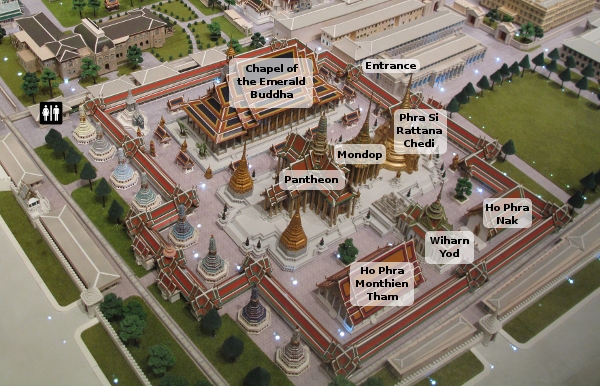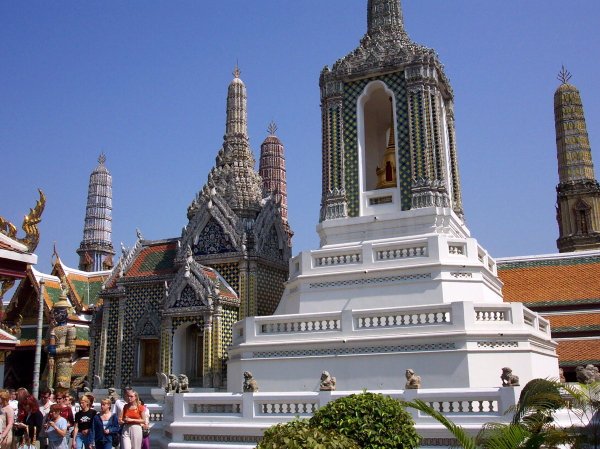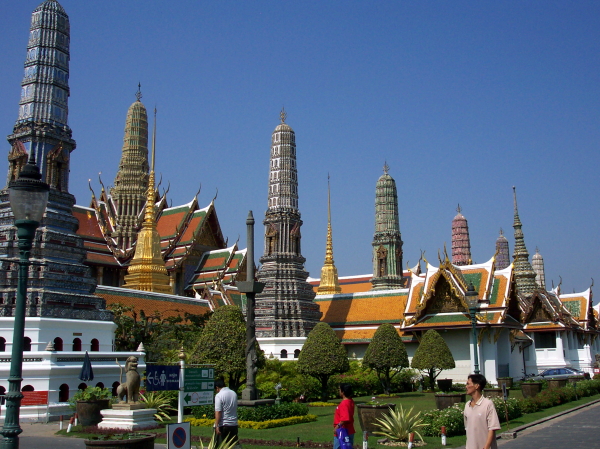 The temple seen from the main entry to the palace
The temple seen from the main entry to the palace
Wat Phra Si Rattanasasadaram, generally called the Temple of the Emerald Buddha in English or Wat Phra Gaeo in Thai, is a temple purpose-built to house a Buddha image carved from a large solid piece of green jadite. Chaophraya Chakri, who went on to become King Rama I, brought the image from Vientiane when he captured the city in 1778. King Rama I built the temple and enshrined the Emerald Buddha there as a symbol of Siam's regained nationhood. The temple does not house any monks. Rather, it is more like the personal chapel of the royal family.
You enter the temple compound on the west side, facing the back of the chapel (ubosot) housing the Emerald Buddha. Most visitors climb up to the upper terrace before proceeding around to the entrance to the chapel. North of the ubosot is an elevated platform with three large buildings in a line. Originally, the temple's main library, the Ho Phra Monthien Tham, was on this spot, but it burned down in a fire caused by fireworks later in the reign of King Rama I. He decided to have the Phra Mondop built on this spot. King Rama IV added the Royal Pantheon and the huge Phra Si Rattana Chedi to the upper terrace. He also commissioned the model of Angkor Wat which sits on the north side of the upper terrace.
North of the elevated terrace are three smaller buildings. At the northeast corner of the courtyard is the Ho Phra Nak, used as a royal columbarium housing the ashes of minor royals. In the center of the northern court is the small Wiharn Yod, which, in a break from the colored mirror tiles of the other buildings, is finished in bits of Chinese porcelain. In the northwest corner is the Ho Phra Monthien Tham, the 'auxiliary library' where Buddhist texts are stored.
South of the ubosot are just a couple of buildings. At the southeast corner is the Chapel of the Gandharara Buddha, built by Rama IV. The Gandhara Buddha was used in rain-making rites. Rama IV also built the bell tower in its current form. If you walk past the exit back around to the rear of the ubosot, you'll find a couple of other interesting structures and photo opportunities.

View from the exit
Almost facing the entrance is a bronze statue clothed in white said to represent the Hindu hermit who invented yoga. Behind the statue, inside the consecrated area of the chapel, is a small tower housing a ringed chedi that King Rama IV brought from the north.
You can take it with you.
Wish you could have this information with you when you visit the Grand Palace? Now you can. Check out our Bangkok Essentials ebook.
The entire temple is enclosed by a covered gallery, the outer wall of which is painted with elaborate scenes from the Ramakien epic. Each entrance is guarded by a pair of huge demons called yakshas. Along the eastern edge of the temple are eight tall prangs.
» Next: Exit the temple to the middle court of the palace.


